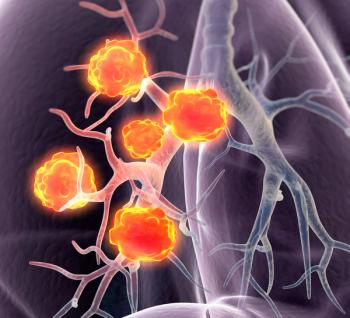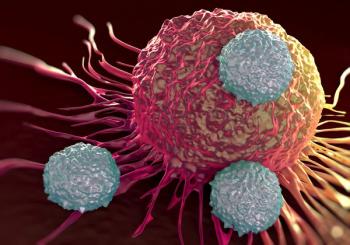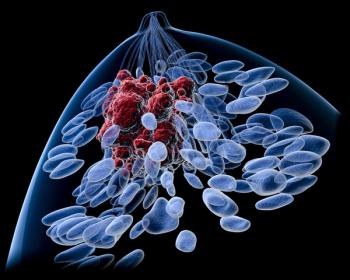
Survival Data for Palbociclib in ER+HER2– Advanced Breast Cancer Reported From PALOMA-2 Final Read-Out
At 2022 ASCO, final survival data from the phase 3 PALOMA-2 trial confirmed similar survival between palbociclib plus letrozole and letrozole alone.
Final overall survival (OS) analysis of the phase 3 PALOMA-2 trial (NCT01740427) indicated that palbociclib (Ibrance) in combination with letrozole as frontline therapy for patients with estrogen receptor (ER)–positive/HER2-negative advanced breast cancer led to similar overall survival (OS) compared with letrozole alone, according to data made available during the
At the November 15, 2021, data cutoff, at a median follow-up of 90 months, patients who received the CDK4/6 inhibitor palbociclib plus letrozole (n = 444) had a median OS of 53.9 months (95% CI, 49.8-60.8) compared with 51.2 months (95% CI, 43.7-58.9) for patients who received placebo plus letrozole (n = 222; HR, 0.956; 95% CI, 0.777-1.777; P = .3378). However, in a post-hoc sensitivity analysis that adjusted for missing survival data, the median OS for patients treated with the combination (n = 385) was 51.6 months (95% CI, 46.9-57.1) compared with 44.6 months (95% CI, 37.0-52.3) for the 175 patients in the control arm (HR, 0.869; 95% CI, 0.706-1.069). The median duration of treatment was 22.0 months and 13.8 months, respectively.
Both arms of the trial had significant amounts of missing survival data; results were missing for 59 patients in the palbociclib plus letrozole arm and for 47 patients in the letrozole monotherapy. Most patients in both arms had died at the time of the analysis (62% and 60%, respectively). Patients were still alive at a rate of 25% and 19%, respectively.
“The OS is numerically longer with palbociclib and letrozole compared with the control arm, though these results were not statistically significant,” Richard S. Finn, MD, professor of medicine, Geffen School of Medicine, University of California Los Angeles, said during the presentation. “However, the median OS of 50 months in this population represents a significant improvement in the natural history of HR-positive breast cancer. Interpretation of OS in PALOMA-2 is limited by the large and disproportionate percentage of patients with missing survival data between the treatment arms.”
In PALOMA-2, patients with ER-positive/HER2-negative advanced breast cancer who had not undergone any prior treatments for advanced disease and had an ECOG performance status of 2 or less were randomized 2:1 into the palbociclib plus letrozole arm or the placebo plus letrozole arm. Patients received 125 mg of palbociclib per day, for 3 weeks on and 1 week off, and 2.5 mg of letrozole per day. In the placebo arm, the same dose of letrozole was given and placebo was given in place of palbociclib at the same dose as the investigational arm.
The primary end point of the trial was investigator assessed progression-free survival (PFS). Secondary end points included OS, response, safety, biomarkers, and patient reported outcomes. Patients were stratified by disease site (visceral vs non-visceral), disease-free interval (DFI; de novo metastatic for 12 months or less vs more than 12 months), and prior treatment with neoadjuvant hormonal therapy (yes vs no).
The baseline patient characteristics were well-balanced between the 2 arms; the median age was 62 years (range, 30-89) in the combination arm and 61 years (range, 28-88). Most patients in both arms had prior endocrine therapy (56% and 57%, respectively). A majority of patients in the combination arm had non-visceral disease (52%) and the disease site was evenly split in the placebo arm. Patients had an ECOG performance status of 0 at a rate of 58% and 46%, respectively, and a status of 1 or 2 at a rate of 42% and 54%, respectively.
The hazard ratios between the 2 arms were approximately 1 for almost all of the subgroups examined in the analysis. However, in subgroups that had approximately equal amounts of missing survival data, the hazard ratios favored the combination.
Patients with an ECOG performance status of 1 or 2 achieved a median OS of 47.3 months (95% CI, 41.3-60.8) compared with 35.8 months (95% CI, 32.2-49.8) in the combination and placebo arms, respectively. In patients previously treated with endocrine therapy, the median OS was 53.3 months (95% CI, 48.0-62.9) and 44.6 months (95% CI, 34.3-52.8), respectively. Patients with bone-only disease achieved a median OS of 63.5 months (95% CI, 53.9-79.7) and 52.3 months (95% CI, 42.3-59.7), respectively.
At the time of the analysis, most patients in the combination arm (90%) and the placebo arm (98%) had discontinued study treatment. Patients went on to receive post-study systemic treatment at a rate of 81% and 88%, respectively. Most patients in both arms went on to receive endocrine therapy (66% and 74%) as well as chemotherapy (55% and 62%). CDK4/6 inhibitors were subsequently given to 12% and 27% of patients, respectively.
The median time to chemotherapy in the combination arm was 38.1 months (95% CI, 34.1-42.2) compared with 29.8 months (95% CI, 24.7-34.8) in the placebo arm (HR, 0.730; 95% CI, 0.607-0.879). A combined OS analysis of PALOMA-2 and the phase 2 PALOMA-1 trial (NCT00721409) revealed that patients who received the palbociclib plus letrozole combination (n = 528) achieved a median OS of 51.8 months (95% CI, 47.8-56.9) compared with 46.8 months (95% CI, 38.8-52.3) for patients in the control group (n = 303; HR, 0.934; 95% CI, 0.780-1.120).
Among patients with a DFI greater than 12 months, the combined analysis indicated that the median OS was 64.0 months (95% CI, 49.2-73.4) and 44.6 months (95% CI, 37.0-53.2), respectively (HR, 0.736; 95% CI, 0.551-0.982).
The most common all-cause, any-grade adverse effects (AEs) in the combination arm of PALOMA-2 included neutropenia (82%), infections (64%), and leukopenia (43%). Common grade 3/4 AEs consisted of neutropenia (69%) leukopenia (27%), and infections (9%).
In the placebo arm, common AEs of any grade included infections (46%), arthralgia (40%), and hot flush (31%). Grade 3 AEs included infections (3%), nausea (2%), and headache (2%).
“The safety profile with this regimen is predictable and is consistent now with seven and a half years of follow-up with no long-term toxicity, and quality of life has been maintained,” Finn noted.
Reference
Finn RS, Rugo HS, Dieras VC, et al. Overall survival (OS) with first-line palbociclib plus letrozole (PAL+LET) versus placebo plus letrozole (PBO+LET) in women with estrogen receptor–positive/human epidermal growth factor receptor 2–negative advanced breast cancer (ER+/HER2− ABC): Analyses from PALOMA-2. J Clin Oncol. 2022;40(suppl 17):LBA1003. doi:10.1200/JCO.2022.40.17_suppl.LBA1003
Newsletter
Stay up to date on recent advances in the multidisciplinary approach to cancer.

















































































